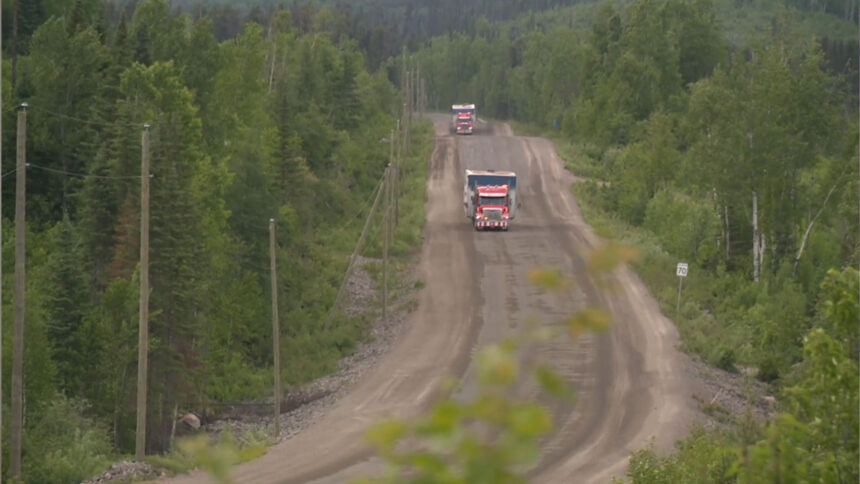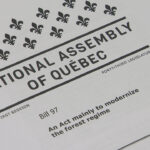Quebec’s proposed new forestry law Bill 97 has become a lightning rod for anger in the province. Indigenous leaders, concerned that the proposed law would erode their inherent and treaty rights, are at the head of opposition to the changes; but they’re not alone, supported by environmental groups, unions, and forestry researchers. Bill 97 is intended mainly to modernize the forest regime, was tabled April 23. With its proposal, Quebec’s Coalition Avenir du Québec (CAQ) government set out to accomplish ambitious changes. The Bill sets out a significant redesign of the way Quebec handles forestry, with sweeping changes to existing laws and a new three-zone (triad) system designed to revolutionize forest management by splitting forests into priority forest development zones (for intense logging), conservation zones, and multi-purpose zones balancing conservation with development. The CAQ government aims for development zones to represent no less than 30% of Quebec forests. According to forest engineer, researcher, and blogger Eric Alvarez, out of the 23.56M hectares of forest identified as potentially exploitable, “This would reserve some eight million hectares for the forest industry alone,” he concluded in a June 10 post. “Eight million hectares where all other stakeholders and users of the public forest will have only one thing to do: keep quiet.” Why this, and why now? Cut logs in Atikamekw. Photo, APTN file. At its core, Bill 97 is an attempt to find a solution to a debate about forestry that has been ongoing in Quebec for more than a quarter century. In the 1980s and 1990s, the province engaged in clearcutting activities that the Coulombe Commission (2003-2004) eventually found to be excessive and destructive. Over the past 20 years, successive Liberal and Parti-Québécois governments have passed legislation to harmonize forestry with the needs of the ecosystem and to place the Quebec government in charge of managing forests, auctioning timber, and setting prices. Bill 97 offers a series of changes: beginning by replacing the reigning principle of ecosystem management with the triad system of zone designation, where new rules also prevent what the bill calls “certain activities that restrict the carrying out of forest development activities, as well as the implementation of conservation measures.” Though controversial to some, Bill 97 found support from industry. In May, soon after it was tabled, an open letter praising the Bill appeared in the Journal de Montréal signed by presidents and CEOs of the Quebec Forest Industry Council, the Canadian Federation of Independent Business, the Quebec Employers Council, Quebec Manufacturers & Exporters, and the Federation of Chambers of Commerce of Quebec. Indigenous Responses: Rejection, Alliance, Expulsion, and Threat of Legal Action Indigenous opposition to Bill 97 came within days of its tabling. In a press release two days after the Bill was proposed, Regional Chief Francis Verreault-Paul of the Association of First Nations Quebec and Labrador (AFNQL) argued the bill ignored Indigenous’ communities’ inherent rights. “The wording of the bill presented on April 23 is extremely surprising and disappointing,” said Verreault-Paul, “especially since we have been discussing this with the minister for over a year and have made clear recommendations that have not been considered.” Indigenous objections are centred around the bill’s lack of recognition of inherent Indigenous rights, coupled with the proposal to privatize one third of the land in Quebec, nearly half of it unceded and not subject to treaties. Sovereignty demonstration outside Wemotaci. Photo, APTN file Multiple leaders have asserted Bill 97 ignores the United Nations Declaration on the Rights of Indigenous Peoples. Before the Planning and the Public Domain Committee of Quebec’s National Assembly in early June, Verreault-Paul was joined by several other chiefs, including Lucien Wabanonik, chief of the Lac-Simon Anishnabe Nation. Wabanonik expressed extreme dissatisfaction with the potential for the bill to hand the forestry industry priority of access to 30% of First Peoples’ ancestral territories, placing First Nations rights subordinate to forestry rights. Wabanonik called Bill 97 “An insult to our intelligence” and “a direct provocation to the members of our community” that “constitutes an act of dispossession of our lands.” He said the bill shows a grudging tolerance for Indigenous people in that it doesn’t prohibit traditional activities—but only if they do not harm logging. Wabonik argues logging takes precedence over Indigenous rights in the eyes of the government of Quebec. “We want to collaborate. But not on the basis of your bill,” he said. “We reject your bill. We can’t restart on a foundation that’s already broken.” In fact, First Nations leaders including Wabanonik began responding to Bill 97 long before it was tabled, during the period of consultations leading up to its drafting. In December, Wabanonik and 19 other chiefs responded to a presentation by the Ministry of Natural Resources and Forests about the planning process with an open letter of firm rejection. That letter tells Minister Maïté Blanchette-Vézina “We categorically reject your proposal and demand a reform that is transparent, equitable and respectful of our ancestral rights. […] Need I remind you of the court’s recent rulings? You have a constitutional duty to consult us properly. You cannot partition the territory to dispossess us of part of our land and offer it to industry.” Alliance and Expulsion On April 11, two weeks before the legislation was tabled, members of the Innu and Atikamekw nations, as well as the Abenaki nations on the south side of the Saint-Lawrence river, formed the group Mamo-Mamu First Nations. Mamo-Mamu, named for the Atikamekw and Innu terms for “together,” describes itself as an alliance of hereditary chiefs and land defenders and does not represent elected Chiefs and Councils. The group responded to the tabling of Bill 97 with a series of blockades and protests in places across Innu and Atikamekw territories, especially on logging roads outside areas like the Innu community of Mashteuiatsh (near Lac Saint-Jean) and the Atikamekw community of Wemotaci near the forestry hub, La Tuque. Some of these protests have been carried as far south as the streets of Montreal. Sovereignty demonstration outside Wemotaci. Photo: APTN file. In May, Mamo-Mamu First Nations, along with the allied group Association des Gardiens du territoire Nehirowisiw Aski, escalated their tactics with a registered letter of expulsion to 11 forestry companies. “Upon receipt of this letter, you are responsible for informing your employees and contractors to leave our territory immediately and until further notice,” the letter stated. “This eviction order specifically targets multifunctional harvesters; we do not want any further logging. […] We hereby inform you that all your employees and contractors must immediately evacuate our unceded traditional Indigenous territories.” At present, members of Mamo-Mamu First Nations continue blockades and other assertions of their presence on logging roads near communities like Manawan Atikamekw First Nation. Threat of Legal Action Some time after the statement by AFNQL and the establishment of Mamo-Mamu First Nation, the Cree Nation Government made its own public statement about the Bill. The Cree Nation of Eeyou Istchee, comprising nine communities east of James Bay, negotiated Canada’s first modern treaty, the James Bay Northern Quebec Agreement, in 1975 with Quebec’s then-Liberal government. They negotiated the subsequent Paix des Braves with the Parti-Québécois government in 2002. At the same time, in the late 1980s the Cree Nation also oversaw a series of coordinated protests and pressure actions against the Quebec government’s plan to dam the Great Whale River (near the present-day Cree-Inuit community of Whapmagoostui-Kuujjuarapik which ultimately resulted in the cancelation of the multi-billion-dollar project. Between protest and negotiation, the Cree Nation has developed a position of political and economic power unique among First Nations in Quebec. Where other First Nations might resort to roadblocks, the Cree Nation Government has often resorted to well-known law firms to provide legal remedies unavailable to many smaller communities. In its press release, the Cree Nation Government acknowledged that Bill 97 mentions it does not take precedence over the provisions of the 2002 Paix des Braves. “The Paix des Braves is a legally binding agreement,” the statement reads, “and the Adapted Forestry Regime set out in the Paix des Braves is incorporated by reference to the JBNQA, which is constitutionally protected. As such, it forms part of the Cree Nation’s treaty framework and reflects the mutual obligations of both the Cree Nation and the Government of Québec.” The Cree Nation’s statement ends by saying its representatives are “conducting a detailed review of Bill 97 and will engage in direct discussions with the Gouvernement du Québec to ensure its implementation respects and is in full accordance with our treaty obligations, shared commitments, and recognized governance structures.” A Strategy Disowned by Its Own Architect, and More Non-Indigenous Opposition While groups like the Canadian Parks and Wilderness Society Quebec, Nature Quebec, the Quebec Environmental Law Centre, and CSN and UNIFOR, the unions representing Quebec’s forestry workers, publicly denounced Bill 97, some of the most damning criticisms came from forestry experts themselves. One of the most striking rejections of the proposed law came from the researcher whose work on triad forestry inspired Bill 97. Professor Christian Messier, a forestry expert from the Université du Québec à Montréal’s biology department, has worked for decades on the triad approach. Minister of Natural Resources and Forests Maïté Blanchette Vézina has invoked his name and his research in developing Bill 97. Yet Messier told newspaper La Presse that Bill 97 “is going to be hell. There’s going to be a breakdown in trust. It’s going to create antagonism.” In a separate opinion piece in La Presse, Messier explains that he led a team in testing the triad-zoning approach to a 1M-hectare region north of La Tuque. Based on that experience, he concludes the three tiers of use should also act as a system of priorities, first protecting biodiversity, then minimizing use conflicts, before maintaining timber production. “The triad should therefore not be implemented with the primary objective of helping the forestry industry, as the minister appears to be presenting,” Messier concludes. In an open letter published in La Presse, signed by 36 experts, four professors from the Quebec’s Forest Research Centre describe Bill 97 as taking “very little account of recent scientific advances in the forestry field.” They note the government did not consult them, despite being a key organization in Quebec forestry bringing together 12 Quebec universities and more than 85 researchers, and publishing more than 200 articles a year. Robert Beauregard, former Dean of the Faculty of Forestry, geography, and geomatics at Laval University, finds key aspects of Bill 97 bear strong similarity to aspects of the ‘80s-era Forest Act that were discarded in 2010. In his own opinion piece in La Presse, Beauregard predicts that if Bill 97 becomes law, forestry will enjoy a brief honeymoon, followed by “massive plant closures in 10 to 15 years.” What Happens Next? Even before the statement from the Cree Nation Government, Minister Blanchette-Vézina signalled a willingness to cede ground on Bill 97. Following public consultations, the Minister made a June 6 post on X, formerly Twitter. The statement reads, in part, “Significant amendments will be made, particularly in collaboration with First Nations. It is essential for me to work with stakeholders in the community—and I will continue to do so this summer. I will return with an improved bill that is up to the challenges facing the forest. We all have a responsibility to engage in respectful dialogue, and the blockades must end. Every job lost in the region is one too many. It is time to act, out of responsibility to the workers and forestry communities who, faced with tariff pressure, need a lifeline more than ever.” By June 9, however, Quebec Premier François Legault appeared to minimize the minister’s comments, saying, “There are no major changes planned for the moment, but adjustments.” He added, “Maïté Blanchette-Vézina always said she was in favor of consulting in committee, which she did. Obviously, when we consult, it’s to improve the bill, but essentially, the bill will continue to be a new system that provides more predictability and ensures jobs in all regions of Quebec. But indeed, we listened to the indigenous peoples, we listened to the people who want to protect the caribou. But it has to be balanced” Whether this will calm uneasy Indigenous opponents, as well as their non-Indigenous counterparts, is uncertain. While Quebec’s National Assembly has recessed for the summer, opponents of Bill 97 have not disappeared. Instead, they are organizing, and some are agitating to bring the debate into Quebec’s population centres. On June 22, organizers held a demonstration against Bill 97 beginning at Montreal’s Olympic Stadium, with some hundred protestors taking to the streets. That protest is only one in a series: the latest Montreal protest against Bill 97 is scheduled to be held next week on July 1. Continue Reading
Opposition grows to proposed forestry bill in Quebec

Leave a Comment










